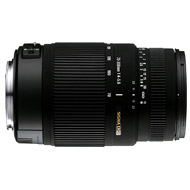What do you think about this photo?Do you have questions or curiosities about this image? Do you want to ask something to the author, give him suggestions for improvement, or congratulate for a photo that you really like?
You can do it by joining JuzaPhoto, it is easy and free!
There is more: by registering you can create your personal page, publish photos, receive comments and you can use all the features of JuzaPhoto. With more than 256000 members, there is space for everyone, from the beginner to the professional.
| sent on July 21, 2017 (13:04) | This comment has been automatically translated (show/hide original)
This shot has something that does not go.
The causes could be 3 .... and you must understand which of the three led you to get a somewhat disappointing result.
1) the focus may be wrong (the moon must be strictly in manual focus and not always the infinity is exactly at the bottom of the ring nut.
2) There may have been an atmospheric velvet or a non-optimal sighting to get all the details that you would have had to register with the equipment you used.
3) Could be the micromax or microtose ... usually .... but it's not a fixed rule, I shoot using a 1/250 sec. And a higher sensitivity of 200 or 400 ISO, but this is not a fixed rule either.
The show goes pretty well ... although I usually prefer herA little darker and more contrasted. Questo scatto ha qualcosa che non va.
Le cause potrebbero essere 3....e va capito quale delle tre ti ha portato ad ottenere un risultato un pò deludente.
1) potrebbe essere sbagliata la messa a fuoco (sulla luna va fatta rigorosamente in manual focus e non sempre l'infinito si trova esattamente a fondo corsa della ghiera.
2) Potrebbe esserci stata della velatura atmosferica o un seeing non ottimale per poter ottenere tutti i dettagli che altrimenti, con l'attrezzatura utilizzata, avresti dovuto registrare.
3) Potrebbe esserci del mosso o micromosso...di solito....ma non è una regola fissa, io scatto usando tempi di un 1/250 sec. e una sensibilità più alta tipo 200 o 400 ISO ma, anche questa non è una regola fissa.
L'esposizione va abbastanza bene....anche se io in genere la preferisco un pochino più scura e contrastata. |
user44198 | sent on July 21, 2017 (14:35) | This comment has been automatically translated (show/hide original)
Fabio, when photographing the Moon, should take a live view in order to avoid that the tipping of the mirror produces the inevitable "move", plus I add that with a 300 mm. You are forced to make a crop so the resolution of the subject is much smaller than the whole frame, to have the surface details we need more millimeters of focal ... let's say from 1000 in there !!!
In this case it is known that the focus is very rough so many of the details are lost in the excursion of the ring :-D :-D
A greeting
Riccardo Fabio,quando si fotografa la Luna bisognerebbe effettuare lo scatto in live view per evitare che il ribaltamento dello specchio produca l'inevitabile "mosso",in più aggiungo che con un 300 mm. sei costretto a fare un crop e quindi la risoluzione del soggetto è assai più piccola rispetto all'interezza del frame, per avere i dettagli superficiali ci servono più millimetri di focale...diciamo dai 1000 in sù!!!
nella fattispecie noto che la messa a fuoco è molto approssimativa per cui molti dei dettagli si sono persi nell'escursione della ghiera  
un saluto
Riccardo |
| sent on July 21, 2017 (16:54)
Ci sono molte immagini nella galleria astrofoto, realizzate con ottiche da 300mm di focale e che mostrano moltissimi dettagli. Io stesso l'ho fotografata con un Pentacon 300 f4 e con un catadiottrico 300 mm f4,5 (guarda nella mia galleria).
Per esperienza ti dico che anche con queste focali i dettagli saltano fuori che è una meraviglia.
Non avevo pensato al fatto che la sfocatura di questa immagine potesse essere causata dalle vibrazioni del ribaltamento dello specchio ma.....si....torna...potrebbe essere benissimo questa la causa.
In effetti quando scatto alla Luna uso anche io delle tecniche per evitare il mosso...oltre a scattare da Live View uso anche lo scatto ritardato di 2 secondi per evitare che le vibrazioni siano innescate dalla pressione del tasto di scatto e, per ultimo ma non per ultimo, le gambe del treppiede alla minima estensione, così che il cavalletto sia più rigido e riassorba più velocemente tutte le vibrazioni.
Ci sono molte immagini nella galleria astrofoto, realizzate con ottiche da 300mm di focale e che mostrano moltissimi dettagli. Io stesso l'ho fotografata con un Pentacon 300 f4 e con un catadiottrico 300 mm f4,5 (guarda nella mia galleria).
Per esperienza ti dico che anche con queste focali i dettagli saltano fuori che è una meraviglia.
Non avevo pensato al fatto che la sfocatura di questa immagine potesse essere causata dalle vibrazioni del ribaltamento dello specchio ma.....si....torna...potrebbe essere benissimo questa la causa.
In effetti quando scatto alla Luna uso anche io delle tecniche per evitare il mosso...oltre a scattare da Live View uso anche lo scatto ritardato di 2 secondi per evitare che le vibrazioni siano innescate dalla pressione del tasto di scatto e, per ultimo ma non per ultimo, le gambe del treppiede alla minima estensione, così che il cavalletto sia più rigido e riassorba più velocemente tutte le vibrazioni. |
user44198 | sent on July 21, 2017 (18:16) | This comment has been automatically translated (show/hide original)
You will also get the details you say, but get them with a 816 mm telescope. Plus a good duplicate work at 1632 mm., I honestly do not see how you can compare the pictures, is like comparing a 500 with a ferrari looking at my last moon and figuring out what we are talking about .... Avrai anche i dettagli che dici di avere,ma ottenendoli con un telescopio di 816 mm. più un buon duplicatone lavori a 1632 mm., io sinceramente non vedo come si possa paragonare le immagini,è come paragonare una 500 con una ferrari guarda la mia ultima Luna e renditi conto di cosa stiamo parlando.... |
| sent on July 21, 2017 (18:32) | This comment has been automatically translated (show/hide original)
Speaking of the details .... I was referring to the photo we are discussing .... I meant that with a 300mm you can get details of the lunar surface even quite defined .... certainly not fine and not small details. The photo commented here does not show it at all.
Vega ..... sure that a 1000's view allows you to get more detail than a 300 octave about this ..... we agree on it ... maybe I was unclear and misunderstood what I meant . Parlando di dettagli....mi riferivo alla foto di cui stiamo discutendo....Intendevo dire che con un 300mm si possono ottenere dettagli della superficie lunare anche piuttosto definiti....certo non fini e non piccoli dettagli. La foto qui commentata non ne mostra affatto.
Vega.....certo che un'ottica da 1000 permette di ottenere più dettaglio che un'ottica da 300.....su questo siamo d'accordissimo...forse sono stato poco chiaro e hai frainteso ciò che volevo dire. |
user44198 | sent on July 21, 2017 (18:53) | This comment has been automatically translated (show/hide original)
But Fabio, no problem, it is clear that the photo commented can not claim more ...
Looking at your gallery you notice, and it is clear, the difference between 300 mm. And your MTO 1000, that's what I meant for perceiving details ... ;-) ;-)
However it is never the Moon to be immortalized ... see seeing dancer, moving, focusing ... and whoever has it more! :-D :-D ma si Fabio,nessun problema,si è chiaro che della foto commentata non si possa pretendere di più...
guardando nella tua galleria si nota,ed è lampante,la differenza tra il 300 mm. e il tuo MTO 1000,ecco cosa intendevo per la percezione dei dettagli... 
comunque sia la Luna non è mai semplice da immortalare...vedi seeing ballerino,il mosso,la messa a fuoco...e chi ne ha più ne metta!!!  |
| sent on July 21, 2017 (19:25) | This comment has been automatically translated (show/hide original)
Apparently banal subject ....! But if you're looking for good results, it's always a challenge! Soggetto apparentemente banale....! Ma se si pretendono buoni risultati è sempre una sfida! |
| sent on July 21, 2017 (20:08) | This comment has been automatically translated (show/hide original)
Let me first say, THANK YOU, but really thanks, in the sense that I did not imagine how a shot like this with all the imperfections that REALLY reported, could trigger a discussion like this. That said, I admit it, is my first "decent" shot if so we can define it in the moon, with a 300 that I have to replace, because despite the remote and delayed 2 sec shot, despite the live view, the result is This, so presumptuously, and I SPERO let me publish it, in order to figure out if it's just the 300 I have to change, or what to adjust in me to get more shots to that term. One thing you've already told me about 300 for dictation to our astronomer is not enough. And I already have a starting point, for the rest I will work on Lasciatemi dire per prima cosa, GRAZIE, ma grazie veramente, nel senso che non immaginavo come uno scatto come questo con tutte le imperfezioni che GIUSTAMENTE riportate, potesse scatenare una discussione come questa. Detto ciò ebbene si lo confesso, è il mio primo scatto " decente" se così lo possiamo definire alla luna, con un 300 che dovrò sostituire, perché nonostante lo scatto in remoto e ritardato di 2 sec, nonostante il live view, il risultato è questo, quindi presuntuosamente, e SPERO me lo consentite l'ho pubblicata, al fine di capire se è solo il 300 che devo cambiare, o cosa aggiustare in me per ottenere scatti più consoni a tale termine. Una cosa già me l'avete detta il 300 per i dettegli al nostro astro non basta. Ed ho già un punto di partenza, per il resto ci lavorerò sopra |
| sent on July 22, 2017 (2:09)
Fox...aspetta a cambiare lente e investire soldi a rava....intanto cerchiamo di capire cosa non ha funzionato in questo scatto.
Se già hai usato accorgimenti come messa a fuoco manuale con il live view, scatto ritardato di 2 secondi e in remoto, magari il problema non sta nell'ottica.
A questa foto manca nitidezza e dettaglio....ma la causa potrebbe benissimo non risiedere ne nell'attrezzatura utilizzata ne nel tuo modo di mettere a fuoco.
La luna, come ho già detto sopra e non stavo scherzando....è un soggetto solo apparentemente semplice.
Il problema più grande sta nel trovare la serata giusta. Non solo nel senso di avere un cielo sereno e senza nuvole, ma anche che non presenti foschia, umidità, vento e correnti ad alta quota...per dirla in termini astronomici la serata deve avere un buon seeing, altrimenti quello che otterrai saranno immagini prive di dettaglio o molto confuse.
La spiegazione è questa: per fotografare la luna devi attraversare con lo sguardo dell'obiettivo tutta l'atmosfera terrestre che, è composta da strati caratterizzati da diverse temperature, diversa umidità e diversa densità. questi strati sono completamente caotici e si comportano, permettimi il termine di paragone, come un sistema di lenti "impazzito". L'aria rifrange la luce in maniera diversa se, tasso di umidità e temperatura dei vari strati atmosferici sono diversi.
Per ottenere i migliori risultati nelle foto alla Luna i consigli che posso darti per mia esperienza sono i seguenti:
-Scegli una serata con cielo sereno e un buon seeing (per capirlo meglio guarda una stella luminosa...più la sua luce sfarfalla peggiore è il seeing)
- Fotografa quando la luna è molto alta sull'orizzonte...in questo modo gli strati atmosferici che devi bucare sono più sottili e inficiano meno negativamente il risultato.
- Usa impostazioni che ti permettano scatti piuttosto veloci (1/250 sec. sarebbe l'ottimale) e non inducano il sensore a tirar fuori troppo rumore elettronico (max 400 ISO). Per quanto riguarda l'apertura della lente e con le impostazioni sopra indicate, dovresti rientrare nel range di maggior nitidezza delle ottiche....tra f 5,6 e f11.
- Usa un treppiede stabile e alla minima altezza in abbinamento a tutte le tecniche anti vibrazione di cui abbiamo già parlato.
Con questi accorgimenti vedrai che riuscirai ad ottenere risultati molto migliori di quello che hai pubblicato (e hai fatto bene a pubblicarlo). Anche il tuo 300 tirerà fuori molto da questo soggetto.
Ottiche più lunghe riescono ad ingrandire di più ma...per ottenere dettagli fini occorre avere anche risolvenza maggiore....e qui cominciano i dolori...
Intanto imparerei a spremere all'osso il tuo obiettivo....poi passerei ad ottiche più lunghe e impegnative.
Fox...aspetta a cambiare lente e investire soldi a rava....intanto cerchiamo di capire cosa non ha funzionato in questo scatto.
Se già hai usato accorgimenti come messa a fuoco manuale con il live view, scatto ritardato di 2 secondi e in remoto, magari il problema non sta nell'ottica.
A questa foto manca nitidezza e dettaglio....ma la causa potrebbe benissimo non risiedere ne nell'attrezzatura utilizzata ne nel tuo modo di mettere a fuoco.
La luna, come ho già detto sopra e non stavo scherzando....è un soggetto solo apparentemente semplice.
Il problema più grande sta nel trovare la serata giusta. Non solo nel senso di avere un cielo sereno e senza nuvole, ma anche che non presenti foschia, umidità, vento e correnti ad alta quota...per dirla in termini astronomici la serata deve avere un buon seeing, altrimenti quello che otterrai saranno immagini prive di dettaglio o molto confuse.
La spiegazione è questa: per fotografare la luna devi attraversare con lo sguardo dell'obiettivo tutta l'atmosfera terrestre che, è composta da strati caratterizzati da diverse temperature, diversa umidità e diversa densità. questi strati sono completamente caotici e si comportano, permettimi il termine di paragone, come un sistema di lenti "impazzito". L'aria rifrange la luce in maniera diversa se, tasso di umidità e temperatura dei vari strati atmosferici sono diversi.
Per ottenere i migliori risultati nelle foto alla Luna i consigli che posso darti per mia esperienza sono i seguenti:
-Scegli una serata con cielo sereno e un buon seeing (per capirlo meglio guarda una stella luminosa...più la sua luce sfarfalla peggiore è il seeing)
- Fotografa quando la luna è molto alta sull'orizzonte...in questo modo gli strati atmosferici che devi bucare sono più sottili e inficiano meno negativamente il risultato.
- Usa impostazioni che ti permettano scatti piuttosto veloci (1/250 sec. sarebbe l'ottimale) e non inducano il sensore a tirar fuori troppo rumore elettronico (max 400 ISO). Per quanto riguarda l'apertura della lente e con le impostazioni sopra indicate, dovresti rientrare nel range di maggior nitidezza delle ottiche....tra f 5,6 e f11.
- Usa un treppiede stabile e alla minima altezza in abbinamento a tutte le tecniche anti vibrazione di cui abbiamo già parlato.
Con questi accorgimenti vedrai che riuscirai ad ottenere risultati molto migliori di quello che hai pubblicato (e hai fatto bene a pubblicarlo). Anche il tuo 300 tirerà fuori molto da questo soggetto.
Ottiche più lunghe riescono ad ingrandire di più ma...per ottenere dettagli fini occorre avere anche risolvenza maggiore....e qui cominciano i dolori...
Intanto imparerei a spremere all'osso il tuo obiettivo....poi passerei ad ottiche più lunghe e impegnative.
|
| sent on July 22, 2017 (18:29) | This comment has been automatically translated (show/hide original)
Thank you Fabio will make you think of what you say, and as soon as I feel the same conditions as you suggest me, I will return to work for a work in progress. Now I will scrutinize the sky as if I were an astronomer. Hi and Thanks again for the suggestions. Grazie Fabio farò tesoro di quanto dici, e non appena riterrò le condizioni simili a quanto mi suggerisci, tornerò all'opera, per un work in progress. Adesso scruterò il cielo quasi fossi un astronomo. Ciao e Grazie ancora per i suggerimenti. |
|

Publish your advertisement on JuzaPhoto (info) |


 Per le vie del Borgo 3
Per le vie del Borgo 3






















 JuzaPhoto contains affiliate links from Amazon and Ebay and JuzaPhoto earn a commission in case of purchase through affiliate links.
JuzaPhoto contains affiliate links from Amazon and Ebay and JuzaPhoto earn a commission in case of purchase through affiliate links.



